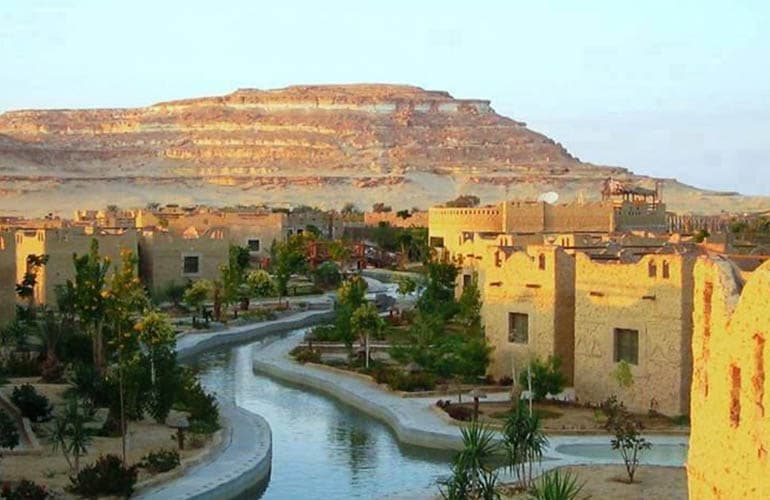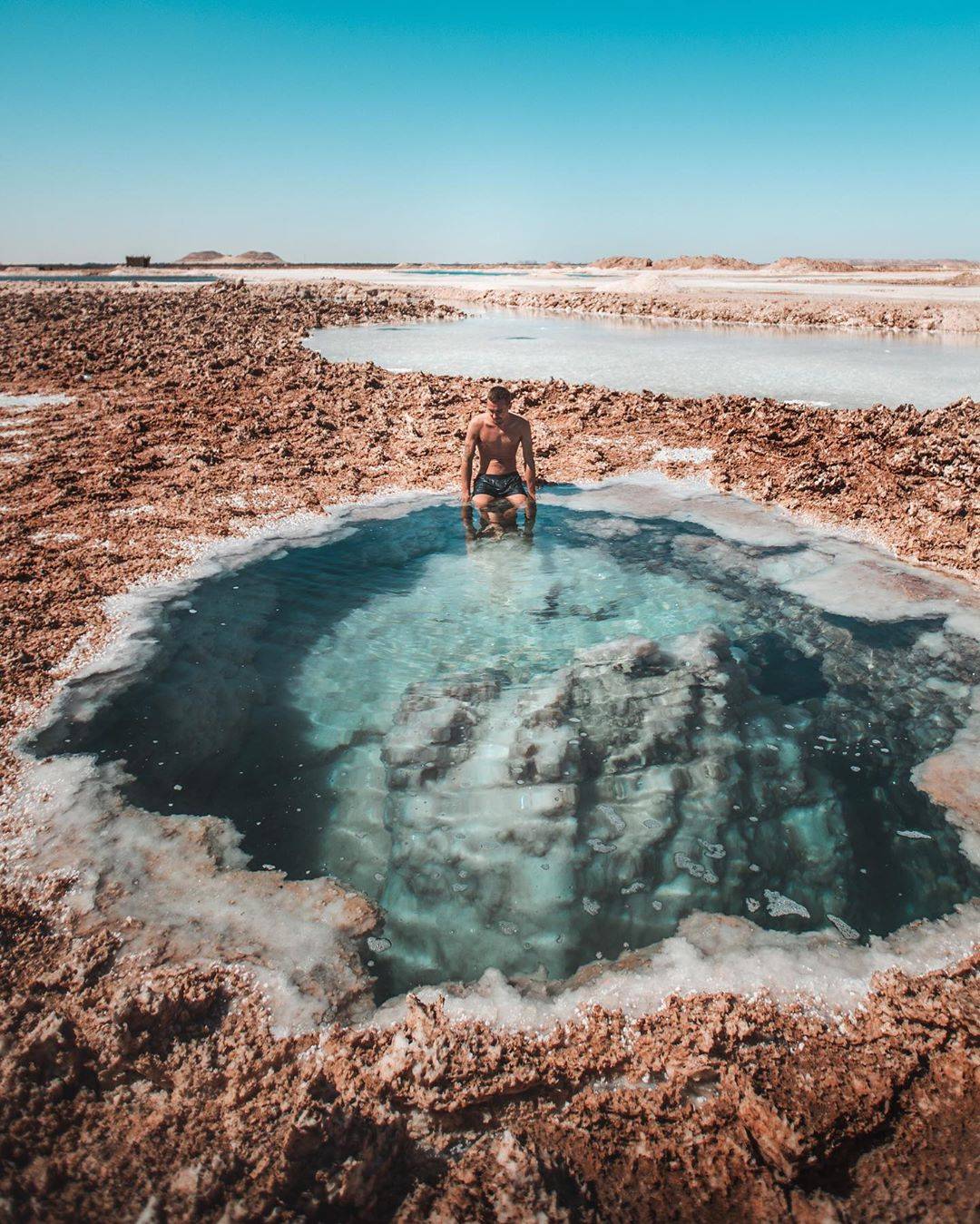The Siwa Oasis in Egypt is a unique and fascinating destination between the Qattara Depression and the Great Sand Sea. It offers visitors a serene retreat with its stunning natural landscapes, abundant springs, and rich history. Exploring its ancient sites and vibrant culture reveals an often overlooked side of Egypt.
Table of Contents
ToggleGeographical Context
The geographical context of Siwa Oasis is defined by its unique location within Egypt’s Western Desert and the distinct climatic conditions that shape its ecology. Understanding these factors provides insight into the oasis’s significance and natural resources.
Location and Topography
Siwa Oasis is approximately 560 kilometers (350 miles) west-southwest of Cairo and about 50 kilometers (31 miles) east of the Libya-Egypt border. Nestled between the Qattara Depression and the Great Sand Sea, it spans roughly 10 kilometers (6 miles) in length and 6 to 8 kilometers (4 to 5 miles) in width. The oasis features two prominent rock outcrops that house ancient settlements. The elevation varies, with portions sitting below sea level due to the adjacent Qattara Depression, making this area geographically distinctive within Egypt.
The oasis is renowned for its numerous freshwater springs—around 200—providing vital resources for local agriculture and inhabitants. These springs are integral to supporting date palm cultivation and other crops, establishing the oasis as a green haven in the arid landscape of the Western Desert.
Climate and Ecology
Siwa Oasis experiences a hot desert climate with extreme temperature variations between day and night. Summer temperatures can soar above 40°C (104°F), while nighttime temperatures may drop significantly. Rainfall is scarce, averaging less than 25 millimeters annually, primarily in winter.
Owing to its water sources, Siwa’s ecology is diverse. The region supports various plant species, including palm trees and olive groves. Additionally, unique wildlife, including reptiles and migratory birds, has adapted to the harsh conditions. The presence of sulfur springs enhances the oasis’s ecological richness, adding to its historical and cultural significance.
Historical Significance
The history of Siwa Oasis is rich and varied, marked by its significance in ancient Egypt, its role in Greek and Roman times, and its more recent historical developments. This oasis has been a site of cultural exchange and spiritual importance.
Ancient Egyptian Period
Siwa Oasis was known for the Oracle of Amun, a significant spiritual center during the 26th Dynasty. The temple, dedicated to Amun, drew many pilgrims seeking guidance and prophecies. The Oracle’s fame extended throughout the ancient world.
Historian Herodotus documented the oracle’s influence, noting that even Alexander the Great visited to seek validation of his divine status as a pharaoh. This event affirmed the oasis’s role in legitimizing rulers. The rich natural resources and strategic location also contributed to its importance as a trade route.
Greek and Roman Influence
Under Greek rule, the oasis remained a vital religious site. The influence of the Roman occupation saw the continued reverence for Amun and the transition of power dynamics in the region. The Romans integrated local beliefs, increasing Siwa’s importance as a cultural melting pot.
The abandonment of traditional beliefs led to a decline in oracle consultations, but the region retained significance due to its unique Amazigh and Berber culture. The local tribes adapted to changing times while holding onto their traditions, making the oasis a historical locus of resilience and continuity.
Modern History and World Wars
Historically, Siwa Oasis has witnessed significant changes due to geopolitical upheaval. The aftermath of World War I brought attention to Egypt’s national identity, with Siwa representing rural life amidst urban expansion.
During World War II, its remote location made it strategically important. Control over the oasis facilitated military movements, reflecting its continued tactical significance. In the years following the wars, Siwa developed as a tourist destination while celebrating its historical legacy. Traditional practices and the local culture became focal points for visitors, intertwining the past with the present.
Natural Wonders and Conservation
Siwa Oasis is home to remarkable natural features that sustain local biodiversity and enhance its cultural landscape. Conserving these natural wonders is essential for maintaining ecological balance and supporting traditional lifestyles.
Springs and Freshwater Sources
The oasis is celebrated for its abundant springs, which provide vital freshwater in the desert. Notable freshwater springs include the Cleopatra Spring, known for its historical significance, and Bir Wahed, which attracts visitors for its swimming opportunities. These springs are crucial for local agriculture, supporting the growth of date palms, olive trees, and various crops.
Preserving these springs is a priority, as they are threatened by over-extraction and climatic changes. Efforts to promote sustainable water usage are vital for the community and Siwa’s ecological health.
Unique Flora and Fauna
Siwa Oasis hosts unique flora and fauna adapted to its arid environment. The landscape is marked by extensive groves of palm and olive trees, which provide habitat for various bird species. The surrounding desert supports diverse wildlife, including the endangered Egyptian turtle.
Conservation initiatives focus on protecting these ecosystems from desertification and invasive species. Local communities engage in traditional farming practices that enhance biodiversity, ensuring the survival of both the unique species and Siwa’s cultural heritage.
Cultural Attractions and Local Life
Siwa Oasis is rich in cultural attractions that reflect its unique history and local traditions. The architectural heritage showcases the ingenuity of its inhabitants, while daily life is intertwined with age-old customs.
Architectural Heritage
Traditional mud-brick houses and the iconic Shali Fortress dominate the architectural landscape of Siwa. This fortification, built from kershif, a mixture of rock salt and mud, is a testament to local construction methods. Visitors can explore the Mountain of the Dead, where ancient tombs are carved into the rock, offering insight into the burial practices of the past.
Another significant site is the Siwa House Museum, which displays local artifacts, including basketry and traditional tools. The pigeon towers, used for housing pigeons that provide meat and fertilizer, also reflect the ingenious adaptation of the locals to their environment. These structures highlight a blend of functionality and aesthetic appeal rooted in the local geography.
Siwa Town and Traditions
Daily life in Siwa revolves around vibrant traditions and community activities. The local economy largely depends on agriculture, particularly the cultivation of olives and dates. Markets buzz with an activity where residents exchange goods and socialize, often over shisha.
Cultural practices include music and dance, which are integral to local festivals. Traditional crafts like basketry are still practiced, preserving ancient methods. Residents participate in rituals unique to the region, reflecting a deep connection to their ancestors.
Encounters with locals offer visitors a glimpse into this rich lifestyle, filled with hospitality and warmth. They showcase how tradition shapes the community’s identity.
Tourism and Recreation
Siwa Oasis offers a blend of adventure and relaxation, making it a unique destination for travelers. Visitors can engage in thrilling activities while finding peace in the area’s natural beauty.
Adventurous Activities
Adventurous travelers can explore Siwa Oasis through various exciting activities. One popular option is a jeep safari across the Great Sand Sea. This adrenaline-fueled experience allows individuals to traverse vast dunes and discover hidden gems.
Visitors also have opportunities for sandboarding. This exhilarating sport provides a fun way to enjoy the sandy landscapes. Additionally, those seeking serenity can embark on a sunset tour to capture stunning views as the sun sinks below the horizon, painting the sky with hues of orange and pink.
Another notable activity is visiting Fantasy Island, where one can swim in crystal-clear waters amidst lush palm trees. These activities combine adventure with breathtaking scenery, ensuring an unforgettable experience in Siwa.
Relaxation and Health Tourism
Siwa Oasis is renowned for its wellness offerings, drawing visitors looking for relaxation and healing. Cleopatra’s Pool, one of the most famed hot springs, is a highlight. People often visit to enjoy the therapeutic qualities of the mineral-rich waters, which are especially beneficial for those with rheumatism and joint pain.
Another unique experience is indulging in sand baths. These natural treatments utilize the healing properties of the desert sand, promoting relaxation and rejuvenation. Additionally, eco-lodges in the area provide eco-friendly accommodations that enhance the serene atmosphere.
Siwa reveals the Milky Way at night, offering a stunning celestial show perfect for stargazers. This fusion of health and tranquility makes Siwa Oasis a compelling destination for those seeking rest and adventure.
Frequently Asked Questions
This section addresses common inquiries about Siwa Oasis and related oases in Egypt. It focuses on historical sites, unique hotel features, cultural differences, and significant temples in the region.
What historical sites can be found at Siwa Oasis?
Siwa Oasis boasts several ancient historical sites. The Temple of the Oracle, dedicated to Amun, is one of the most famous, attracting visitors for its historical significance. Additionally, the ruins of the ancient town of Shali showcase traditional Siwan architecture.
What unique features do The Oasis Hotel Pyramids offer?
The Oasis Hotel Pyramids highlights stunning views of the Giza Pyramids. It offers spacious accommodations and amenities designed for comfort and relaxation. Guests can enjoy many dining options that reflect local and international cuisine.
What are the reasons to visit The Oasis Marsa Alam?
The Oasis Marsa Alam is known for its beautiful beaches and vibrant marine life. The clear waters of the Red Sea allow visitors to engage in activities like snorkeling and diving. The area’s serenity attracts those seeking a tranquil getaway.
What amenities are available at The Oasis Hotel Cairo?
The Oasis Hotel Cairo provides a range of amenities, including free Wi-Fi, a swimming pool, and fitness facilities. Guests can enjoy on-site dining options that cater to different tastes. The hotel offers convenient access to local attractions.
How does the culture of Siwa Oasis differ from the rest of Egypt?
Siwa Oasis has a distinct culture influenced by Berber traditions. The local community maintains unique customs, language, and crafts that differentiate them from mainstream Egyptian culture. This includes traditional clothing and distinctive architectural styles in local buildings.
What significant temples are located in Siwa, Egypt?
In addition to the Temple of the Oracle, the Temple of Isis is another notable site in Siwa. These temples were centers of worship and played significant roles in the spiritual life of the oasis’ inhabitants. They reflect the rich history and religious practices of ancient Egyptian civilization.
